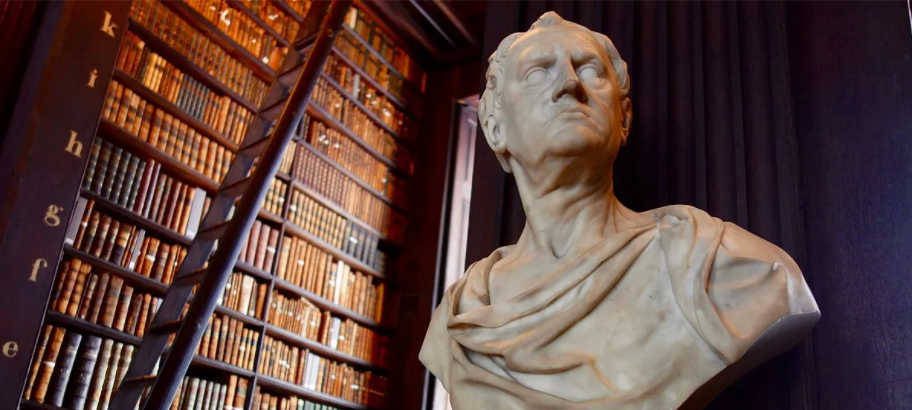by ThinkingWest
Perhaps no other topic has been written about in the West more than Christianity. In the past 2,000 years, tomes on the faith have been written by kings, monks, prophets, and laymen alike. One might conclude that no other faith has inspired, and been inspired by, great literature quite like Christianity. Therefore, in our next series of articles, we aim to highlight the most prolific literature of Christianity. These works were written to lead and inspire the faithful through practical application of teachings or by theological and philosophical exploration of Christianity’s mysteries. In this first installment, we will focus on the years 0-600 A.D. to investigate the earliest Christian works.
Let’s explore the most important works of the early church.
Published on thinkingwest.com on February 13, 2023.
1. The Bible (circa 15th century B.C – 1st century A.D., various authors)
No list of Christian literature could be taken seriously without including the most famous book of all time: the Bible. Coming from the Latin biblia literally meaning “book,” the Bible is actually a collection of books written by various authors starting in the late Bronze Age up until the Roman Era in the 1st century. Consisting of the “Old” testament which features Jewish history, prophecy, and poetry, and the “New” testament focused on the life of Christ and the development of the early church, the Bible is central to Christianity because, according to the faithful, it is the word of God. The current canon of books was formalized in the fourth century through various councils: the Council of Rome (382), the Council of Hippo (393), and the Council of Carthage (397)*.
“In the beginning God created the heavens and the earth. Now the earth was formless and empty, darkness was over the surface of the deep, and the Spirit of God was hovering over the waters. And God said, “Let there be light,” and there was light.”
Genesis Chapter 1, Verses 1-3
*Note: Biblical canon varies slightly between several denominations such as Catholic, Eastern Orthodox, and Protestants among others.

*To view where to purchase a book, simply click on the book image*
2. The Didache (1st Century A.D., Anonymous)
The Didache is a brief discourse written in the first century that contains catechetical, ethical, and ritualistic teachings. Detailed instructions on the rites of baptism and the Eucharist, as well fasting practices and the complete Lord’s Prayer are contained within. In one section, the Didache reflects on two divergent paths: the “Way of Life,” and the “”Way of Death,” reminding the reader to “bear the whole yoke of the Lord” and to avoid certain vices. In the section on baptism, the author prescribes the well-known formula “in the Name of the Father, and of the Son and of the Holy Ghost” to be recited as the person is immersed in “living water” when available. If the water is not suitable for immersion, it may be poured three times on the person’s head. This section is particularly fascinating because the rite described is so familiar to Christians today, as the document affirms that the formula used in baptism now is the same as that used by the earliest Christians in the first century. Though mentioned by early Christians such as Eusebius, the Didache was lost to history until its rediscovery in 1883 by Greek Orthodox Metropolitan Bryennios of Nicomedia.
“You shall not exalt yourself, nor give over-confidence to your soul. Your soul shall not be joined with lofty ones, but with just and lowly ones shall it have its intercourse. Accept whatever happens to you as good, knowing that apart from God nothing comes to pass.”
Anonymous, The Didache

3. The Shepherd of Hermas (Likely 2nd Century, Hermas)
The Shepherd of Hermas was a popular book among Christians in the first few centuries after Christ’s death. Some church fathers such as Iranaeus even considered the work to be canonical scripture. Hermas, a freed slave living in the Roman empire and brother to Pope Pius I, is thought to be the author, though this is disputed. Some have hypothesized that the author is the same Hermas that Paul refers to in his letter to the Romans. The book centers around several visions, commandments, and parables given to the author in order to further the faithful’s understanding of Christian ethics. In one interesting vision, the author sees a tower built of stones representing the Church made up of its baptized members. An angel explains that the baptized can be cast out of the Church if they commit grave sins, though are admitted back after repentance. The Shepherd is often compared to the more modern work Pilgrim’s Progress because it is believed to be mostly allegorical while revealing certain truths.
“Only be not thou careless, but take courage, and strengthen thy family. For as the smith hammering his work conquers the task which he wills, so also doth righteous discourse repeated daily conquer all evil. Cease not therefore to reprove thy children; for I know that if they shall repent with all their heart, they shall be written in the books of life with the saints.”
Hermas,The Shepherd of Hermas

4. Church History (4th Century, Eusebius)
Eusebius wrote Church History in an attempt to chronicle the development of the early church from the time of the apostles until his time in the 4th century. As bishop of Caesarea, Eusebius had access to the Library of Caesarea (a highly influential Christian library that once housed over 30,000 texts), which allowed him to piece together a narrative of the early church through letters, martyr accounts, lists of bishops, and other documents. His work focuses primarily on the following topics: bishops’ line of succession in the principal sees; notable Christian teachers; heresies; Jewish history; Christian relations with non-Christians; and martyrdoms. The bishop’s work contains many quotes from original sources that have since been lost making Church History a work of historical importance. Scholarly consensus is divided over the accuracy of the work. Some critics have accused Eusebius of outright fabrication, while most modern scholars make a more nuanced case that Eusebius attempted his best with the limited resources he had at his disposal.
“But most wonderful of all is the fact that we who have consecrated ourselves to him, honor him not only with our voices and with the sound of words, but also with complete elevation of soul, so that we choose to give testimony unto him rather than to preserve our own lives.”
Eusebius of Caesarea, Church History

5. On the Incarnation (4th century, Athanasius of Alexandria)
A fourth century classic, On the Incarnation was written by Saint Athanasius, bishop of Alexandria, as a defense of Christ’s nature against various heresies that were prominent at the time. Athanasius explains why God became man as a solution to what he calls the “divine dilemma” of man’s fallen nature. He also expounds upon the nature of the Trinity and pushes back against the Arian heresy claiming that Jesus had been created by God. The work quotes scripture extensively while explaining the teachings of the early Church. The book has been hugely influential on Christian theology even until modern times. C.S. Lewis said of the work, “When I first opened his De Incarnatione I soon discovered by a very simple test that I was reading a masterpiece.“
“He, the Life of all, our Lord and Saviour, did not arrange the manner of his own death lest He should seem to be afraid of some other kind. No. He accepted and bore upon the cross a death inflicted by others, and those other His special enemies, a death which to them was supremely terrible and by no means to be faced; and He did this in order that, by destroying even this death, He might Himself be believed to be the Life, and the power of death be recognised as finally annulled. A marvelous and mighty paradox has thus occurred, for the death which they thought to inflict on Him as dishonor and disgrace has become the glorious monument to death’s defeat.”
St. Athanasius, On the Incarnation

6. Confessions (400 A.D., Augustine of Hippo)
Confessions is a work that we’ve written about multiple times (here and here) for good reason. Saint Augustine’s autobiography has maintained a wide readership since it was first completed circa 400 A.D. In the work Augustine reflects on his sinful youth and eventual conversion to Christianity as he traversed the late Roman empire. Augustine tells of his time as a member of the Manichaean religion, his profession as a successful orator, the bloody spectacle of the gladiatorial games, and struggles with chastity. His work features two other notable figures that played a role in his conversion and joined him in sainthood: Saint Monica, his mother, and Saint Ambrose, the bishop of Milan with whom he debated fiercely. In addition to his autobiography, Augustine includes his contemplations on theological and metaphysical topics in later chapters such as the nature of time and various interpretations of the book of Genesis.
“And men go abroad to admire the heights of mountains, the mighty waves of the sea, the broad tides of rivers, the compass of the ocean, and the circuits of the stars, yet pass over the mystery of themselves without a thought.”
St. Augustine of Hippo, Confessions

7. The City of God (Early 5th century A.D., Augustine of Hippo)
Another classic by Augustine, this early 5th century philosophical work presents the saint’s intellect in full force. The City of God was a response to critics who suggested that the decline of Rome was brought about by the rise of Christianity. The work depicts the human condition as a battleground between the “earthly city” and the “city of God” and all of history as a war between God and the Devil. The denizens of the earthly city are those that have given themselves to the concerns and vices of the material world, while the citizens of the city of God are those that have given up the cares of this world in the hope of the next. All people, cities, governments, and military forces, knowingly or unknowingly, work toward the earthly city led by the Devil, or toward the city of God guided by God. Augustine’s work is considered one of the great theological works of all time and has been highly influential to Western philosophers and theologians throughout the centuries.
“This joy in God is not like any pleasure found in physical or intellectual satisfaction. Nor is it such as a friend experiences in the presence of a friend. But, if we are to use any such analogy, it is more like the eye rejoicing in light.”
Augustine of Hippo, City of God

8. Sayings of the Desert Fathers (circa 5th century A.D., various authors)
The Sayings of the Desert Fathers, as the title suggests, is a collection of texts describing various wisdom stories and maxims attributed to the desert fathers, who were some of the earliest hermits and ascetics living mostly in Egypt during the 5th century. Most of the stories take the form of a conversation between a younger monk and a spiritual elder or “abba,” where the elder bestows wisdom to his counterpart. Early monks looked to these stories for inspiration and spiritual guidance as many figures mentioned in the text are canonized saints like St. Anthony the Great and St. Moses the Black. Early theologians like Jerome and Augustine were possibly influenced by the work. Many of the stories were originally oral traditions in the Coptic language, but were later written down in Greek.
“The devil appeared to a monk disguised as an angel of light, and said to him, ‘I am the angel Gabriel, and I have been sent to you.’ But the monk said, ‘Are you sure you weren’t sent to someone else? I am not worthy to have an angel sent to me.’ At that the devil vanished.”
Anonymous, Sayings of the Desert Fathers

9. Rule of Saint Benedict (516 A.D., Benedict of Nursia)
No other work has influenced monastic life as much as The Rule of Saint Benedict. Since Benedict of Nursia first formulated his guidelines in 516 AD, the rule has been followed by Benedictine monks as well as other religious orders for fifteen centuries. The work is simply a guidebook on how monks should live communally. Benedict’s plan was intended as a moderate path between the extreme asceticism of solitary monks and the more formal institutions of the Church. This “middle way” emphasizes the practices of prayer and manual labor while maintaining a strong community among participants. Benedict modeled his vision of the ideal monastic life on the family and, though written mainly for monks, is also relevant to religious women living under an abbess. This broad applicability helped to popularize the work as it could be used by a variety of communities. Since his work has been so highly influential and long-lasting, Benedict is often credited with being the founder of western monasticism.
“Idleness is the enemy of the soul; and therefore the brethren ought to be employed in manual labor at certain times, at others, in devout reading.”
Benedict of Nursia, The Rule of Saint Benedict

10. Pastoral Care (590 A.D., Gregory the Great)
Shortly after his papal inauguration in 590, Pope Gregory I penned Pastoral Care, a short exposition outlining the responsibilities of clergy. The work focused on how parish priests could best manage their flock and the standards a priest should be held to. Critics pointed out that many of the moral and intellectual standards Gregory espoused were unrealistic for the ordinary clergyman. Despite this, the book proved to be hugely popular in both the east and west. Byzantine Emperor Maurice ordered that it should be distributed among all the bishops within his empire.
“No one does more harm in the Church than he who has the title or rank of holiness and acts perversely.”
Gregory the Great, Pastoral Care


Thinking West aims to revive the “Great Conversation” in our digital age through promoting the study of the great books of the western world, classical approaches to education, and through thoughtful commentary on current events, history, philosophy, culture, education, and religion.
We strive first and foremost to spark an appreciation for the values that built the West. Our content strives for depth and meaning in an era plagued by six second attention spans and clickbait headlines. We challenge ourselves and our readers to read, reflect, and speak out on ideas that matter.
Find us online at:
thinkingwest
and
YouTube
Sources
Featured Image: https://www.flickr.com/photos/30478819@N08/31437597767
License: https://creativecommons.org/licenses/by/2.0/legalcode





